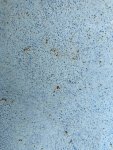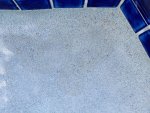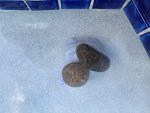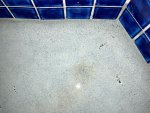Just had our pool replastered with Diamond-Brite in April. We've been trying to keep pH at 7.2 per instructions but it likes to climb with the new plaster up to 8.0. (Today's test results below.) Yesterday, I noticed rust and black colored spots in the pool, particularly in creases. Some but not all of the spots would "smear" like they were oily but I wasn't really able to scrape any off and smear onto white paper. A nylon brush did nothing; a small metal pick did diminish but not eliminate the discoloration; a steel brush make a modest improvement but I don't know if that's too harsh on the plaster. It seems that the discoloration is largely in the pores of the plaster.
The deck was recoated after the pool plaster was done and considered that it may have been "over spray" of a chemical for that, but the clustering of the spots in creases doesn't support that theory (IMHO).
I'm inclined to conclude it's black algae but research suggests it may be due to metals. I tried putting a trichlor tablet on some of the spots but didn't see any change; maybe my poor technique or impatience. Didn't try the "vitamin C" test.
There are also a few patches of mustard/green algae, but not much. Still, an indication of inadequate chlorination.
The current measurements are below. The FC level does drop because high temperatures and long work days. Yesterday morning, it was 2.0.
Is 50 ppm CYA the correct target for north Texas considering the heat? We're using 2-3 gallons of 6% bleach a week. Is that typical?
I'm inclined to treat for black algae by superchlorinating and brushing. I guess I need an all-steel brush - correct? Are these available in 18"-24" widths for the end of the pole? Or narrower for more force? Any specific recommendations?
Thanks for any guidance,
Lloyd
pH 7.5
FC 6.5
CC 0.5
ALK 70
CH 400
CYA ~50

The deck was recoated after the pool plaster was done and considered that it may have been "over spray" of a chemical for that, but the clustering of the spots in creases doesn't support that theory (IMHO).
I'm inclined to conclude it's black algae but research suggests it may be due to metals. I tried putting a trichlor tablet on some of the spots but didn't see any change; maybe my poor technique or impatience. Didn't try the "vitamin C" test.
There are also a few patches of mustard/green algae, but not much. Still, an indication of inadequate chlorination.
The current measurements are below. The FC level does drop because high temperatures and long work days. Yesterday morning, it was 2.0.
Is 50 ppm CYA the correct target for north Texas considering the heat? We're using 2-3 gallons of 6% bleach a week. Is that typical?
I'm inclined to treat for black algae by superchlorinating and brushing. I guess I need an all-steel brush - correct? Are these available in 18"-24" widths for the end of the pole? Or narrower for more force? Any specific recommendations?
Thanks for any guidance,
Lloyd
pH 7.5
FC 6.5
CC 0.5
ALK 70
CH 400
CYA ~50





